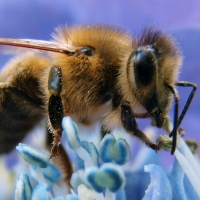Lawsuit Blames State Pesticide Agency Stalling in Honeybee Disaster

Birds do it, bees do it and a pesticide is blamed for it. “It,” in this case, is the unnatural decline worldwide of avian and insect populations. A new Dutch study links declining bird populations for the first time—through the decline of insects they eat—to a family of pesticides known as neonicotinoids.
The link of neonicotinoids to honeybees is not new, and because it is not new, a coalition of advocacy groups sued California’s Department of Pesticide Regulation (DPR) this week to do something about it.
Honeybees, which are crucial to California’s agricultural industry, have been dying out in unprecedented numbers since 2006. Land use and other factors can be at play, but pesticides have been one of the suspects from the beginning in the admittedly complex honeybee collapse.
The lawsuit (pdf), filed by Earthjustice on behalf of Pesticide Action Network, Center for Food Safety and Beyond Pesticides, points out that, “None of this is news” to the department.
The suit says the DPR was “compelled” to re-evaluate its position on allowing neonicotinoid use in 2009 based on evidence about its potential harm. Five years of “foot-dragging,” while expanding the pesticide’s acceptable use, is a violation of the California Environmental Quality Act (CEQA) and other laws, the suit contends.
The department was supposed to be done in two years. Instead, it is still working on developing protocols for gathering data while evidence mounts that the pesticide has a vast and deadly reach far beyond the area of its initial application. The pesticide is up and down the food chain. The suit says:
“Over the last 15 years, DPR has registered at least 264 individual pesticide products containing one or more of these four active ingredients for use in California. Today, nitrogaunidine neonicotinoids are among the most widely used pesticides in California and the nation.”
Dead honeybees are a big deal, especially in California. Around 1,300 bee keepers bring more than 1.2 million colonies to California to pollinate the state's almond trees annually, accounting for 75% of the bees used locally. The bees are then used to pollinate dozens of other fruit, vegetable and field crops.
California produces 82% of the world's almonds on about 800,000 acres of land from Tehama County to Kern County. The nuts were the state's No. 1 agricultural export in 2012 at $2.5 billion, more than double that of wine.
As the Dutch study makes evident, things that kill insects indirectly kill other things. Like an economy or an ecosystem.
The lawsuit asks the court to order DPR to immediately vacate approval it gave in June 2013 for expanded use of two powerful neonicotinoid insecticides―Venom Insecticide and Dinotefuran 20SG. The groups want the agency to stop registering any new neonicotinioids or products just like them, finish its re-evaluation and issue its mitigation measures and/or restrictions.
They also asked the court to smack DPR around for “failing to act expeditiously to protect honeybees from exposure to neonicotinioids pending its re-evaluation.”
State legislation to compel DPR action on neonicotinoids was introduced last February. It is still undergoing changes, but the date for compliance has already been pushed back three years to July 1, 2018.
–Ken Broder
To Learn More:
Pesticide Blamed for Bee Deaths Now Linked to Bird Declines (by Geoffrey Mohan, Los Angeles Times)
Greens Accuse California of Killing Honeybees (by Rebekah Kearn, Courthouse News Service)
Focus is on Pesticides as 80,000 Bee Colonies Damaged or Destroyed (by Ken Broder, AllGov California)
Assembly 1789 (California Legislative Information)
Pesticide Action Network North America, et al v. California Department of Pesticide Regulation (Alameda County Superior Court of California) (pdf)
- Top Stories
- Controversies
- Where is the Money Going?
- California and the Nation
- Appointments and Resignations
- Unusual News
- Latest News
- California Forbids U.S. Immigration Agents from Pretending to be Police
- California Lawmakers Urged to Strip “Self-Dealing” Tax Board of Its Duties
- Big Oil’s Grip on California
- Santa Cruz Police See Homeland Security Betrayal in Use of Gang Roundup as Cover for Immigration Raid
- Oil Companies Face Deadline to Stop Polluting California Groundwater





